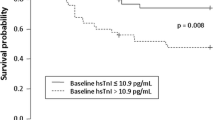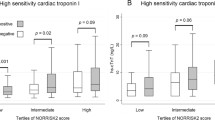Abstract
N-terminal pro-B-type natriuretic peptide (NT-proBNP) and cardiac troponins (cTns) measured with sensitive assays provide strong prognostic information in patients with stable coronary artery disease. However, the relationship between these biomarkers and myocardial contractile function, as well as infarct size, in this patient group, remains to be defined. The study population consisted of 160 patients referred to a follow-up echocardiography scheduled 1 year after coronary revascularization. Concentrations of NT-proBNP, high-sensitive cTnT (hs-cTnT) and sensitive cTnI assays were assessed. Left ventricular function was measured as global peak systolic longitudinal strain by speckle tracking echocardiography and infarct size was assessed by late-enhancement MRI. NT-proBNP and sensitive cTnI levels were significantly associated with left ventricular function by peak systolic strain (R-values 0.243 and 0.228, p = 0.002 and 0.004) as well as infarct size (R-values 0.343 and 0.366, p = 0.014 and p = 0.008). In contrast, hs-cTnT did not correlate with left ventricular function (R = 0.095, p = 0.231) and only marginally with infarct size (R = 0.237, p = 0.094). NT-proBNP and sensitive cTnI levels correlate with left ventricular function and infarct size in patients with stable coronary artery disease after revascularization. As opposed to hs-cTnT, NT-proBNP and cTnI seem to be indicators of incipient myocardial dysfunction and the extent of myocardial necrosis.

Similar content being viewed by others
References
Hemingway H, McCallum A, Shipley M, Manderbacka K, Martikainen P, Keskimaki I (2006) Incidence and prognostic implications of stable angina pectoris among women and men. JAMA 295:1404–1411
Eggers KM, Al-Shakarchi J, Berglund L, Lindahl B, Siegbahn A, Wallentin L, Zethelius B (2013) High-sensitive cardiac troponin T and its relations to cardiovascular risk factors, morbidity, and mortality in elderly men. Am Heart J 166:541–548
Bibbins-Domingo K, Gupta R, Na B, Wu AH, Schiller NB, Whooley MA (2007) N-terminal fragment of the prohormone brain-type natriuretic peptide (NT-proBNP), cardiovascular events, and mortality in patients with stable coronary heart disease. JAMA 297:169–176
Hallen J (2012) Troponin for the estimation of infarct size: what have we learned? Cardiology 121:204–212
Antman EM, Tanasijevic MJ, Thompson B, Schactman M, McCabe CH, Cannon CP, Fischer GA, Fung AY, Thompson C, Wybenga D, Braunwald E (1996) Cardiac-specific troponin I levels to predict the risk of mortality in patients with acute coronary syndromes. N Engl J Med 335:1342–1349
Omland T, de Lemos JA, Sabatine MS, Christophi CA, Rice MM, Jablonski KA, Tjora S, Domanski MJ, Gersh BJ, Rouleau JL, Pfeffer MA, Braunwald E (2009) A sensitive cardiac troponin T assay in stable coronary artery disease. N Engl J Med 361:2538–2547
Ndrepepa G, Braun S, Mehilli J, Birkmeier KA, Byrne RA, Ott I, Hosl K, Schulz S, Fusaro M, Pache J, Hausleiter J, Laugwitz KL, Massberg S, Seyfarth M, Schomig A, Kastrati A (2011) Prognostic value of sensitive troponin T in patients with stable and unstable angina and undetectable conventional troponin. Am Heart J 161:68–75
de Lemos JA, Drazner MH, Omland T, Ayers CR, Khera A, Rohatgi A, Hashim I, Berry JD, Das SR, Morrow DA, McGuire DK (2010) Association of troponin T detected with a highly sensitive assay and cardiac structure and mortality risk in the general population. JAMA 304:2503–2512
Kragelund C, Gronning B, Kober L, Hildebrandt P, Steffensen R (2005) N-terminal pro-B-type natriuretic peptide and long-term mortality in stable coronary heart disease. N Engl J Med 352:666–675
Ndrepepa G, Braun S, Niemoller K, Mehilli J, von Beckerath N, von Beckerath O, Vogt W, Schomig A, Kastrati A (2005) Prognostic value of N-terminal pro-brain natriuretic peptide in patients with chronic stable angina. Circulation 112:2102–2107
Gravning J, Smedsrud MK, Omland T, Eek C, Skulstad H, Aaberge L, Bendz B, Kjekshus J, Morkrid L, Edvardsen T (2013) Sensitive troponin assays and N-terminal pro-B-type natriuretic peptide in acute coronary syndrome: prediction of significant coronary lesions and long-term prognosis. Am Heart J 165:716–724
Montgomery DE, Puthumana JJ, Fox JM, Ogunyankin KO (2012) Global longitudinal strain aids the detection of non-obstructive coronary artery disease in the resting echocardiogram. Eur Heart J Cardiovasc Imaging 13:579–587
Smedsrud MK, Sarvari S, Haugaa KH, Gjesdal O, Orn S, Aaberge L, Smiseth OA, Edvardsen T (2012) Duration of myocardial early systolic lengthening predicts the presence of significant coronary artery disease. J Am Coll Cardiol 60:1086–1093
Smedsrud MK, Pettersen E, Gjesdal O, Svennevig JL, Andersen K, Ihlen H, Edvardsen T (2011) Detection of left ventricular dysfunction by global longitudinal systolic strain in patients with chronic aortic regurgitation. J Am Soc Echocardiogr 24:1253–1259
Woo JS, Kim WS, Yu TK, Ha SJ, Kim SY, Bae JH, Kim KS (2011) Prognostic value of serial global longitudinal strain measured by two-dimensional speckle tracking echocardiography in patients with ST-segment elevation myocardial infarction. Am J Cardiol 108:340–347
Sarvari SI, Gjesdal O, Gude E, Arora S, Andreassen AK, Gullestad L, Geiran O, Edvardsen T (2012) Early postoperative left ventricular function by echocardiographic strain is a predictor of 1-year mortality in heart transplant recipients. J Am Soc Echocardiogr 25:1007–1014
D’Andrea A, Cocchia R, Caso P, Riegler L, Scarafile R, Salerno G, Golia E, Di SG, Calabro P, Bigazzi MC, Liccardo B, Esposito N, Cuomo S, Bossone E, Russo MG, Calabro R (2011) Global longitudinal speckle-tracking strain is predictive of left ventricular remodeling after coronary angioplasty in patients with recent non-ST elevation myocardial infarction. Int J Cardiol 153:185–191
Cerqueira MD, Weissman NJ, Dilsizian V, Jacobs AK, Kaul S, Laskey WK, Pennell DJ, Rumberger JA, Ryan T, Verani MS (2002) Standardized myocardial segmentation and nomenclature for tomographic imaging of the heart: a statement for healthcare professionals from the Cardiac Imaging Committee of the Council on Clinical Cardiology of the American Heart Association. Circulation 105:539–542
Kim RJ, Wu E, Rafael A, Chen EL, Parker MA, Simonetti O, Klocke FJ, Bonow RO, Judd RM (2000) The use of contrast-enhanced magnetic resonance imaging to identify reversible myocardial dysfunction. N Engl J Med 343:1445–1453
Reisner SA, Lysyansky P, Agmon Y, Mutlak D, Lessick J, Friedman Z (2004) Global longitudinal strain: a novel index of left ventricular systolic function. J Am Soc Echocardiogr 17:630–633
Stanton T, Leano R, Marwick TH (2009) Prediction of all-cause mortality from global longitudinal speckle strain: comparison with ejection fraction and wall motion scoring. Circ Cardiovasc Imaging 2:356–364
Kearney LG, Lu K, Ord M, Patel SK, Profitis K, Matalanis G, Burrell LM, Srivastava PM (2012) Global longitudinal strain is a strong independent predictor of all-cause mortality in patients with aortic stenosis. Eur Heart J Cardiovasc Imaging 13:827–833
Gjesdal O, Hopp E, Vartdal T, Lunde K, Helle-Valle T, Aakhus S, Smith HJ, Ihlen H, Edvardsen T (2007) Global longitudinal strain measured by two-dimensional speckle tracking echocardiography is closely related to myocardial infarct size in chronic ischaemic heart disease. Clin Sci (Lond) 113:287–296
Haugaa KH, Smedsrud MK, Steen T, Kongsgaard E, Loennechen JP, Skjaerpe T, Voigt JU, Willems R, Smith G, Smiseth OA, Amlie JP, Edvardsen T (2010) Mechanical dispersion assessed by myocardial strain in patients after myocardial infarction for risk prediction of ventricular arrhythmia. JACC Cardiovasc Imaging 3:247–256
Mistry N, Abdelnoor M, Seljeflot I, Hoffmann P, Bohmer E, Bjornerheim R, Kjeldsen SE, Halvorsen S (2011) Amino-terminal pro-B-type natriuretic peptide (NT-proBNP) levels 3 months after myocardial infarction are more strongly associated with magnetic resonance-determined ejection fraction than NTproBNP levels in the acute phase. J Card Fail 17:479–486
Ndrepepa G, Braun S, Schulz S, Fusaro M, Keta D, Pache J, Seyfarth M, Mehilli J, Schomig A, Kastrati A (2011) Sensitive troponin and N-terminal probrain natriuretic peptide in stable angina. Eur J Clin Investig 41:1054–1062
Omland T, Pfeffer MA, Solomon SD, de Lemos JA, Rosjo H, Saltyte BJ, Maggioni A, Domanski MJ, Rouleau JL, Sabatine MS, Braunwald E (2013) Prognostic value of cardiac troponin I measured with a highly sensitive assay in patients with stable coronary artery disease. J Am Coll Cardiol 61:1240–1249
Giannitsis E, Katus HA (2004) Comparison of cardiac troponin T and troponin I assays–implications of analytical and biochemical differences on clinical performance. Clin Lab 50:521–528
Lyck HM, Saaby L, Nybo M, Rasmussen LM, Thygesen K, Mickley H, Svenstrup PT (2012) Discordant diagnoses of acute myocardial infarction due to the different use of assays and cut-off points of cardiac troponins. Cardiology 122:225–229
Mohammed AA, Januzzi JL Jr (2010) Clinical applications of highly sensitive troponin assays. Cardiol Rev 18:12–19
Twerenbold R, Jaffe A, Reichlin T, Reiter M, Mueller C (2012) High-sensitive troponin T measurements: what do we gain and what are the challenges? Eur Heart J 33:579–586
Bruder O, Jensen C, Jochims M, Farazandeh M, Barkhausen J, Schlosser T, Sabin GV, Hunold P (2010) Relation of B-type natriuretic peptide (BNP) and infarct size as assessed by contrast-enhanced MRI. Int J Cardiol 144:53–58
Ingkanisorn WP, Rhoads KL, Aletras AH, Kellman P, Arai AE (2004) Gadolinium delayed enhancement cardiovascular magnetic resonance correlates with clinical measures of myocardial infarction. J Am Coll Cardiol 43:2253–2259
Sjoli B, Orn S, Grenne B, Ihlen H, Edvardsen T, Brunvand H (2009) Diagnostic capability and reproducibility of strain by Doppler and by speckle tracking in patients with acute myocardial infarction. JACC Cardiovasc Imaging 2:24–33
Conflict of interest
Jørgen Gravning has received lecture fees from Siemens. Torbjørn Omland has received speaker honoraria and research support from Roche Diagnostics.
Author information
Authors and Affiliations
Corresponding author
Rights and permissions
About this article
Cite this article
Smedsrud, M.K., Gravning, J., Omland, T. et al. Sensitive cardiac troponins and N-terminal pro-B-type natriuretic peptide in stable coronary artery disease: correlation with left ventricular function as assessed by myocardial strain. Int J Cardiovasc Imaging 31, 967–973 (2015). https://doi.org/10.1007/s10554-015-0646-6
Received:
Accepted:
Published:
Issue Date:
DOI: https://doi.org/10.1007/s10554-015-0646-6




